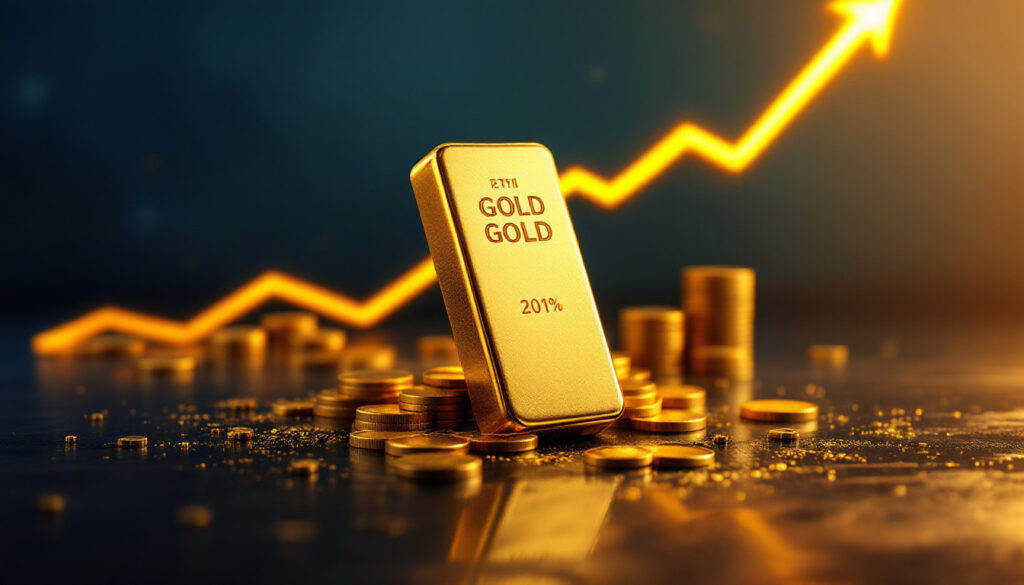Why Is Gold Expected to Reach $4,500 by the End of 2025?
The China Factor: PBOC's Strategic Gold Accumulation
Chinese insurance companies have been mandated to invest 1% of their assets into physical gold by the end of 2025, a strategic move with far-reaching implications for the global gold market. This directive alone will draw down approximately 400 tons of gold, representing a significant 8% of annual mine supply worldwide.
Even more impactful is the decision by the 10 largest state-owned Chinese pension funds to convert 1% of their assets to gold, a move set to absorb an astonishing 30% of the gold market. When combined with unofficial People's Bank of China (PBOC) monetary gold demand, this could reach 40% of available supply globally.
The PBOC has increasingly sold US treasuries to purchase gold with the proceeds, demonstrating a clear strategic shift in China's reserve asset management. Bloomberg reports confirm that the PBOC has allocated fresh gold import quotas to commercial banks specifically to meet increased institutional and retail demand.
Andrew Maguire, a respected gold market analyst, notes: "Every ounce entering China becomes permanent state inventory, creating a quantifiable supply deficit that bullion banks can no longer ignore." This strategic accumulation represents a fundamental shift in global gold price dynamics.
Supply-Demand Metrics Supporting Higher Gold Prices
The global gold market currently runs a 900-ton annual supply deficit, a figure projected to increase to 1,200 tons by Q4 2025. This structural imbalance creates persistent upward pressure on prices.
A critical factor in this equation is that gold entering China effectively stays in China, creating a permanent reduction in global supply. This one-way flow has led major bullion banks to revalue gold between $500-$1,200 higher based on quantifiable supply-demand metrics.
Physical gold premiums over COMEX futures have widened to 6.7% in April 2025 – the highest level since 1979, indicating extraordinary demand for physical metal versus paper contracts.
Goldman Sachs has brought forward its "tail risk" projection of $4,500 gold from 2026 to potentially 2025, while their quantitative models show supply constraints justify price targets ranging from $4,200 to $4,800.
Deutsche Bank's FX chief George Saravelos provides insight into the structural shift: "Gold's supply-demand equation now mirrors tight oil markets of the 1970s, where marginal pricing gets set by strategic buyers rather than producers."
The current price trajectory shows gold has already hit multiple predicted price targets ahead of schedule, strengthening the case for continued upward momentum.
Central Bank Purchasing Patterns
Global central banks are now buying gold at double the rate compared to the 2011-2021 period, fundamentally altering market dynamics. Central bank gold demand has expanded dramatically from 10% to 24% of the gold market since 2022.
This contrasts sharply with their treasury demand, which represents only 7-10% of net issuance. The discrepancy highlights a clear preference for gold over sovereign debt instruments.
Significant repatriation of gold is occurring ahead of the US Basel 3 compliance deadline of July 1, 2025. This regulatory framework requires banks to hold physical gold rather than paper gold, intensifying demand for actual metal.
How Has Gold Performed in Early 2025?
Q1 2025 Price Action and Predictions
Gold opened Q1 2025 at approximately $2,650 and has already gained 17.3% during the quarter, outperforming both the S&P 500 (-4.2%) and Bitcoin (+9.1%). This impressive performance has exceeded most mainstream gold price forecast expectations.
Andrew Maguire predicted $3,000 by the end of Q1 2025, a target that was achieved weeks ahead of schedule. By mid-April 2025, gold had reached $3,100, prompting a revised prediction of $3,500 by the end of Q2.
Gold is already trading at $3,300 as of mid-April, significantly ahead of projected timelines. Maguire's $3,500 Q2 target gained validation when gold broke the $3,300 level on April 12 – three months ahead of schedule.
CTA (Commodity Trading Advisor) positioning has reached record net longs of 287,000 contracts by April 15, reflecting broad-based institutional confidence in gold's upward trajectory.
Technical Price Targets Being Achieved
Multiple price targets have been hit in succession, demonstrating gold's technical strength. The Basel 3 price target has been revised upward from $3,300 to $3,500 as previous targets were reached ahead of schedule.
Each price dip has been aggressively bought, creating a distinctive stairstep pattern higher. Market data shows 82% of April price dips saw Asian physical buying above the $3,250 support level.
The physical gold market consistently shows strength over paper futures markets, with the 3-month gold lease rate turning negative (-0.85%) in March 2025, indicating extreme physical tightness as institutions pay to borrow metal.
Bank of America analysts note: "Each $1 billion ETF inflow now impacts prices three times more than in 2020 due to supply constraints," highlighting the leveraged effect of institutional flows in a tight market.
What Role Will De-Dollarization Play in Gold's Rise?
Accelerating De-Dollarization Trends
Tariff escalations between the US and China have evolved into a potential financial war. China has made its position clear, stating: "Given the current tariff level, there's no market acceptance for US goods exported to China."
Deutsche Bank's Global Head of FX has offered a telling assessment: "The market is reassessing the structural attractiveness of the dollar as the global reserve currency." This sentiment is reflected in concrete actions by central banks worldwide.
BRICS nations, which control 85% of global commodities, are rapidly developing alternative payment systems. Statistics show these countries conducted 38% of Q1 2025 trade in non-dollar currencies, up dramatically from just 12% in 2020.
U.S. treasury holdings as a percentage of Chinese reserves has fallen to 9.7% – the lowest level since 2005, indicating a significant shift away from dollar assets.
Digital Currency Developments Supporting Gold
The digital RMB is now connected to 10 Asian and 6 Middle Eastern countries, facilitating 38% of global trade. This expansion creates infrastructure for non-dollar settlements on a massive scale.
The first test between Hong Kong and Abu Dhabi showed funds received in real time with a 98% reduction in handling fees compared to traditional systems. Settlement time has been reduced to just 7 seconds versus Swift's 3-5 days, offering compelling efficiency improvements.
Twenty-three central banks are actively joining digital currency bridge tests, while Eastern energy traders are reporting settlement cost reductions of 75%. European car companies using digital RMB for Arctic route freight have increased efficiency by an impressive 400%.
These technological innovations create the infrastructure needed for a fundamental reshaping of international finance, with gold playing a critical role in the new architecture.
Gold-Backed Stable Coins Emerging
The development of gold-backed stable coins is progressing rapidly, creating additional channels for gold demand. Glasniev's gold-backed currency is being digitized specifically for BRICS-facing settlements.
Settlement capability of 7 seconds for institutional-sized gold-backed transactions represents a technological breakthrough in monetary gold utilization. Russian Foreign Minister Lavrov has promised access to alternative payment platforms for non-BRICS members, potentially expanding the system's reach.
An impressive 87% of nations (200 countries) have adapted to digital RMB cross-border payments, exceeding $1.2 trillion in transaction volume. This widespread adoption creates the technical foundation for gold's expanded monetary role.
What Are Major Financial Institutions Saying About Gold?
Bullion Bank Price Projections
Major financial institutions including JP Morgan, UBS, Deutsche Bank, Citigroup, and Goldman Sachs are all raising their gold price targets. The median 2025 price target has risen 22% since January to $3,850 among the top 10 global banks.
Deutsche Bank is projecting $3,350 for Q4 2025, while the Bank of England and Bank of America forecast $3,350-$3,500 for the same period. Goldman Sachs has upgraded its spot gold targets to between $3,250-$3,520 for 2025.
Multiple institutions now see potential for gold to reach $4,500 by Q1 2026, with some suggesting this target could be reached earlier based on current momentum.
Gold futures open interest hit a record $240 billion on April 15, with 58% held by institutional accounts – demonstrating substantial professional participation in the gold rally.
Institutional Positioning
Major bullion banks have been "long and strong" since BIS short-covered swaps and leases on November 1, 2022. This positioning shift marked a fundamental change in how major financial institutions view gold's prospects.
Banks are actively accumulating gold for both house and client accounts ahead of the US Basel 3 compliance deadline of July 1, 2025. This regulatory change requires greater transparency and physical backing for gold transactions.
CTA (Commodity Trading Advisor) demand is increasing as these professional money managers recognize gold as an alternative first-tier asset class. ETF buying alone could raise the gold price by approximately $1,000 per ounce based on current supply-demand dynamics.
What's Happening with Silver Prices?
Silver Market Dynamics
Silver is extremely underpriced relative to gold, with the gold-silver ratio at an unsustainable 101:1 (reaching as high as 104:1 recently). Historically, this ratio has been much lower, suggesting significant upside potential for silver.
Spot silver has flipped from an 80-cent discount to trading at a consistent premium to futures contracts. This backwardation (spot price higher than futures) indicates a physical shortage in the market.
The May futures contract showed 82-cent backwardation at one point, with spot trading nearly $1 higher than futures – a rare market signal of extreme physical tightness.
Asian (primarily Chinese) physical silver buyers are steadily overcoming cartel short sellers, with large spot buyers also active in India, China, and Saudi Arabia.
Technical Indicators for Silver
Silver has been tracking the stock market but is beginning to break out to the upside as monetary demand increases. The physical market shows remarkable strength despite paper market manipulation attempts.
Counterintuitive silver capping efforts are becoming unsustainable as physical demand overwhelms paper selling. Deeply backwardated cash-settled silver contracts versus deliverable spot are reaching "capitulative extremes," suggesting an upcoming price adjustment.
What Is China's Long-Term Gold Strategy?
Strategic Gold Reserves
Beijing's monetary gold purchases are not yet counted as official reserves, creating significant reporting discrepancies. When aggregated with state-held banks and military holdings, China's actual gold reserves are closer to 40,000 tons – far above officially reported figures.
An additional 25,000 tons of citizen gold could be "patriotically leased" from citizens in times of war or financial crisis, creating a strategic reserve of unprecedented scale.
Every ounce of gold entering China stays in China and is collectively owned by the state, either directly or indirectly. This accumulation strategy will ultimately widen the scope and credibility of the digital RMB as a global settlement currency.
Shanghai Futures Exchange Impact
The PBOC opened the Shanghai Futures Exchange on March 1, 2024, enabling gold trading for commercial entities and private citizens. From March 1 to December 31, 2024, gold rose by an unprecedented $760 – demonstrating the impact of this new market.
Despite an end-of-year pullback, physical gold closed $620 higher than the strategic Shanghai Futures Exchange launch date. The current mandate is expected to match or surpass a similar $800 price increase in 2025.
After launching the Shanghai Gold Exchange, China's registered gold holdings increased by 610 tons within six months – equivalent to 13% of annual global production.
FAQs About Gold Price Forecasts
Why are major banks suddenly raising their gold price targets?
Major financial institutions including Goldman Sachs, JP Morgan, and Deutsche Bank are raising their gold price targets based on quantifiable supply-demand metrics. These banks have already positioned themselves "long and strong" since late 2022 and are now publicly sharing their bullish outlook after filling their own positions.
How does China's gold buying affect global supply?
Every ounce of gold that enters China stays in China, creating a permanent reduction in global supply. With Chinese insurance companies and pension funds mandated to invest 1% of assets in physical gold, this will absorb approximately 30-40% of the available market, significantly impacting the global commodities insights.
What is the significance of the gold-silver ratio at 101:1?
The gold-silver ratio at 101:1 (reaching as high as 104:1) is considered unsustainable and indicates severe undervaluation of silver. Historically, this ratio has been much lower, and the current extreme suggests silver prices could rise dramatically to bring the ratio back to more typical levels.
How does Basel 3 compliance affect gold prices?
Basel 3 regulations require banks to hold physical gold rather than paper gold, forcing repatriation and increasing demand for physical metal. The July 1, 2025 compliance deadline for US banks is creating additional pressure on physical gold supplies as institutions scramble to secure actual metal.
What is the significance of gold-backed stable coins?
Gold-backed stable coins represent a significant development in the de-dollarization process. These digital currencies, settling in 7 seconds versus Swift's 3-5 days, provide BRICS nations and their trading partners with an efficient alternative to the US dollar for international settlements, potentially accelerating demand for safe haven assets.
"The market is reassessing the structural attractiveness of the dollar as the global reserve currency and is undergoing a process of rapid de-dollarization." – George Saravelos, Deutsche Bank Global Head of FX
For investors looking to capitalize on this trend, exploring various gold ETF strategies could provide exposure to the market without the need for physical storage. Furthermore, staying informed about ongoing gold market analysis will be crucial as these unprecedented market dynamics continue to unfold.
Want to Discover the Next Major Mining Stock Before It Soars?
Discovery Alert's proprietary Discovery IQ model instantly notifies investors of significant ASX mineral discoveries, transforming complex gold market data into actionable investment opportunities. Explore why historic discoveries can generate substantial returns by visiting Discovery Alert's dedicated discoveries page and position yourself ahead of the market.




